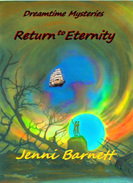
 |
In this third installment of the Dreamtime Mysteries series, Barnett returns to the familiar territory of Australia and the myths and spiritual history of Aboriginal culture. The densely woven narrative unfolds in rich, meticulous detail that centers on two protagonists and a sprawling cast of characters. Broken into five parts, Barnett’s historical-fantasy novel is complete with relevant illustrations, footnotes, and a bibliography.
At its start, anthropology student Rex Graham is nearing the completion of his graduate studies and thesis research into Aboriginal peoples and dreamtime legends. But dark fears resurface, plaguing Rex with worries of his mental health while “in turmoil” over his emotions and developing romance with Audrey. He fears ruining his chances with revelations of his psychic abilities to connect with ancestors through dreams. For guidance, he turns to the fond memories of his grandmother, Granelda, her comforting voice encouraging him to embrace his “special gift, a legacy from your indigenous ancestry.”
Rex and Audrey confront their feelings for one another and soon become engaged. As Rex introduces Audrey to his family, the curiosities of the past come to the fore, especially when Audrey happens upon memoirs collected by Rex’s grandmother. They are not in chronological order, a task for Rex that Audrey suspects will offer Rex the answers he seeks. Haunted by the “deep, dark mysteries” of his indigenous past, the discovery of the collected memoirs and a mysterious brass key prompts Rex to fully delve into the “rich history of Aboriginality” of his family. He traces the stories across the Bancroft family through memoirs, letters, and records, fueled by a compulsive need to understand his own past and prove that he is a “human being of substance, not a ‘half-caste halfwit.’” Something else fuels Rex’s desperate search for answers that Barnett explores in a related subplot—the ongoing, obsessive feud with the Griffin family, whereupon Rex finds evidence of malfeasance against his own grandfather, James Bancroft.
Meanwhile, Audrey, like Rex, embarks on her own parallel journey beginning around part four of the novel. Here, Audrey examines her own Riverland peoples and family history, revisiting their resting place at “Nanda, the tree of eternity." Together, she and Rex discover cave paintings linked to her people’s past, and like Rex, Audrey gradually comes to realize her own similar abilities “to tap into the past through her dreams.” They share “a rare gift of Aboriginality, the ability to tap into ancestral history,” making them a perfect connection.
At the heart of Barnett’s time-shifting and dense story is the decades-long trauma of racial oppression and atrocities against Aboriginal peoples in a “white-dominated society.” The multi-layered novel, built with stories within stories, touches on difficult themes of race relations, genocide, destiny, loss, and redemption. The memoirs fill in a good portion of the novel before Barnett ultimately returns to Rex and Audrey’s story. It is uncertain which parts of the narrative are the most captivating, as each story supports the novel as a whole. The novel is intricately detailed, probing a large array of characters, individually and collectively, across decades. Impressively, Barnett never seems to lose narrative control, but the strength of the novel rests primarily on Rex and Audrey, their tale intermixing with the other stories. By its end, everything seems to make sense.
Barnett writes with straightforward prose and dialogue, though some of the dialogue is a bit wooden at times. The interconnected stories make for an unorthodox read filled with history, magical realism, and mystery. The story engages the reader with an opportunity to learn something about Australia’s complex history. Through this novel, Barnett remarks on humanity’s transgressions and gives voice to displaced peoples and the nearly forgotten. It is through Rex and Audrey that the reader recognizes our universal need for truth and identity in this dreamy fable.